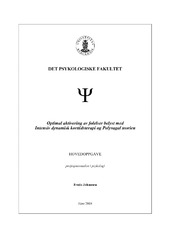| dc.contributor.author | Johansen, Frode | |
| dc.date.accessioned | 2019-01-16T14:19:54Z | |
| dc.date.available | 2019-01-16T14:19:54Z | |
| dc.date.issued | 2018 | |
| dc.date.submitted | 2019-01-14T23:00:18Z | |
| dc.identifier.uri | https://hdl.handle.net/1956/18911 | |
| dc.description.abstract | Due to little difference in the outcome data between the various therapy models there has been a growing interest in therapy-integration and the underlying mechanisms that explain the factors of change in psychotherapy. Focus on feelings is one such mechanism where the well-known window of tolerance functions as a supportive conceptual framework. Polyvagal theory has been an inspiration for the development of this framework and also serves as an explanatory theory. Less known is the theory of pathways of anxiety developed by Intensive Short-Term Dynamic Psychotherapy. This theory has explained and operationalized three different ways anxiety is channeled in the body and their corresponding relationship to dimensions such as emotional access, defense mechanisms, self-observation, and different categories of somatic disorders. This paper will take a closer look at the intersection between these two theories and the concrete contributions from Intensive short-term dynamic psychotherapy to the clinical understanding of the window of tolerance. Finally it will suggest some research directions involving heart rate variability as it is considered an objective measure of autonomic function and emotion regulation. | en_US |
| dc.description.abstract | Som følge av liten forskjell i utfallsdata mellom de ulike terapimodellene har det vært en voksende interesse for terapi-integrasjon og de underliggende mekanismene som kan forklare endringsfaktorer i psykoterapi. Fokus på følelser er en slik mekanisme, hvor det velkjente toleransevinduet fungerer som et støttende konseptuelt rammeverk. Polyvagal teorien har vært en inspirasjon i utviklingen av dette rammeverket og fungerer også som en forklarende teori. Mindre kjent er angstkanaliseringsteorien utviklet av Intensiv dynamisk korttidsterapi. Denne teorien har forklart og operasjonalisert tre forskjellige måter angst kanaliseres i kroppen samt deres sammenfallende relasjon til dimensjoner som emosjonell tilgang, forsvarsmekanismer, selvobservasjon og ulike kategorier av somatiske plager. Denne artikkelen vil se nærmere på hvordan to teoriene kan belyse hverandre og hvordan Intensiv dynamisk korttidsterapi kan bidra til en utvidet klinisk forståelse av toleransevinduet. Avslutningsvis vil den foreslå fremtidig forskning som involverer hjerteratevariabilitet da dette ansees som et objektiv mål på autonom funksjon og emosjonsregulering. | en_US |
| dc.language.iso | nob | eng |
| dc.publisher | The University of Bergen | eng |
| dc.subject | optimal activation | eng |
| dc.subject | window of tolerance | eng |
| dc.subject | ISTDP | eng |
| dc.subject | Intensive Short-Term Dynamic Psychotherapy | eng |
| dc.subject | Polyvagal theory | eng |
| dc.subject | therapy-integration | eng |
| dc.subject | feelings | eng |
| dc.title | Optimal aktivering av følelser belyst med Intensiv dynamisk korttidsterapi og Polyvagal teorien | eng |
| dc.title.alternative | Optimal activation of feelings in light of Intensive Short-Term Dynamic Psychotherapy and Polyvagal theory | eng |
| dc.type | Master thesis | |
| dc.date.updated | 2019-01-14T23:00:18Z | |
| dc.rights.holder | Copyright the Author. All rights reserved | eng |
| dc.description.degree | Hovedoppgave psykologprogrammet | |
| dc.description.localcode | PROPSY317 | |
| dc.description.localcode | PRPSYK | |
| dc.subject.nus | 736102 | eng |
| dc.subject.nsi | VDP::Samfunnsvitenskap: 200::Psykologi: 260::Klinisk psykologi: 262 | |
| fs.subjectcode | PROPSY317 | |
| fs.unitcode | 17-0-0 | |
